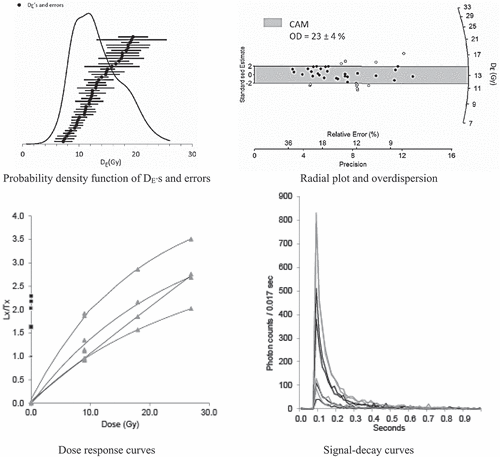Figures & data
Figure 1. A) Inset map showing the state of Tennessee (shaded) and location of the two sediment profiles within the Chickamauga Reservoir. Black point in 1A corresponds to the location of the profiles shown in 1B. B) DEM of the study area with location of the sediment profiles. C) Geologic map of the study area. Information obtained from USGS Tennessee Geologic Map Data (https://mrdata.usgs.gov/geology/state/state.php?state=TN) and DEM interpretation.
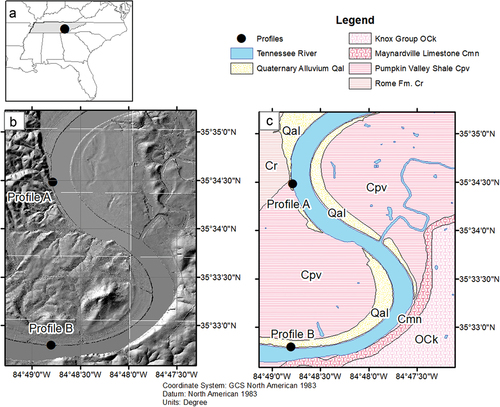
Figure 2. Stratigraphic columns and field photographs with ages obtained from AMS radiocarbon (black font) and OSL (blue font). A) profile a (cut-bank) with zoomed-in photograph of horizons 3Ab/Bt, 3BCb, and 4Ab/Bt. B) profile B (point-bar).
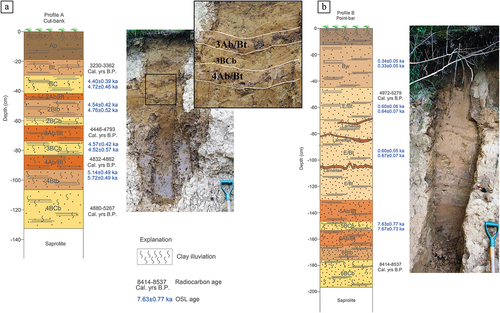
Figure 3. Photomicrographs of oriented soil thin sections. A) Profile A, contact between Ap and Bt, PPL. Crescent and layered clay coatings composed of clay particles and iron oxides. B) Profile A, contact between Ap and Bt, XPL. C) Profile A, contact between Ap and Bt, PPL. Crescent and layered clay coatings composed of clay particles and iron oxides. Bottom right clay coating shows direction of soil water flow downward. D) Profile A, contact between Ap and Bt, NU. Root section fluorescent under UV. E) Profile A, 4BCb, PPL. Charcoal fragment and loose sand grains. F) Profile A, 3Ab/Bt, XPL. Several crescent clay coatings fill pore walls and coating grains. Well-developed coatings can be observed as the extinction of the clay coatings is the same in several layers of clay.
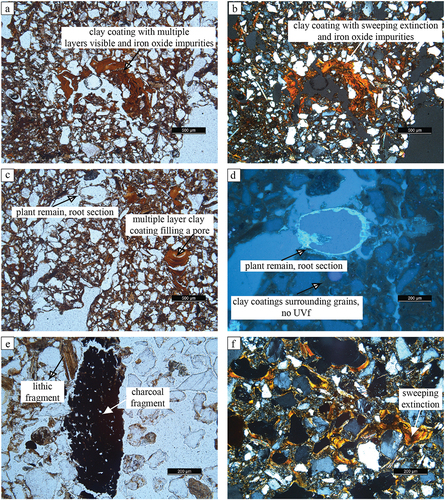
Figure 4. Photographs of whole thin sections for Profile A. Dark red to brownish red features are clay coatings. Spheroidal elements with distinct circular shapes are fecal pellets. Discolorations within the same thin section correspond to evidence of bioturbation as animal burrows. Root casts and walls can be observed as elongated and irregular pore spaces. Black features correspond to fragments of charcoal. A) Contact between Ap and Bt. B) BC. C) 3Ab. D) Contact between 3BCb and 4Ab/Bt. E) Contact between 4Ab and 4Btb. F) 4BCb.

Figure 5. Photomicrographs of paleosols and alluvium horizons. A) Profile B, Bw, PPL. Very few crescent and layered clay coatings. Soil matrix surrounding mineral grains of quartz, feldspar, plagioclase, amphibole, and micas. B) Profile B, Bw, PPL. Soil matrix surrounding grains. High clay content. Charcoal fragments of sand grain size. C) Profile B, contact between Bw and E/Bt, PPL. Soil matrix surrounding mineral grains. Root section. D) Profile B, contact between Bw and E/Bt, NU. Charred root section nonfluorescent under UV. Weakly developed thin clay coatings surrounding mineral grains. Fungi Mycelium in bottom of photomicrograph, fluorescent under UV NU light. E) Profile B, E/Bt, PPL. Lithic fragment. F) Profile B, contact between 6Btb and 6BCb, XPL. Several crescent clay coatings fill pore walls and coating grains. Well-developed coatings can be observed as the extinction of the clay coatings is the same in several layers of clay.
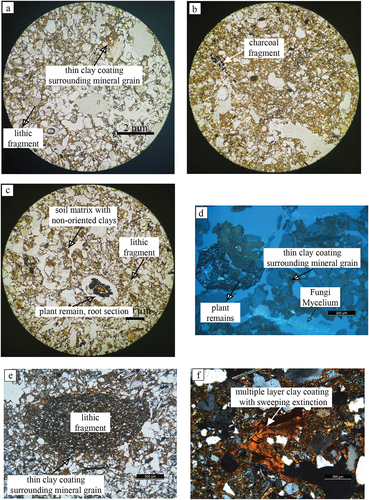
Figure 6. Photographs of whole thin sections for Profile B. Dark red to brownish red features are clay coatings. Spheroidal elements with distinct circular shapes are fecal pellets. Discolorations within the same thin section correspond to evidence of bioturbation as animal burrows. Root casts and walls can be observed as elongated and irregular pore spaces. Black features correspond to fragments of charcoal. A) Upper Bw. B) Lower Bw. C) Contact between Bw and E/Bt. D) Upper E/Bt. E) Middle E/Bt. F) Contact between 6Btb and 6BCb.
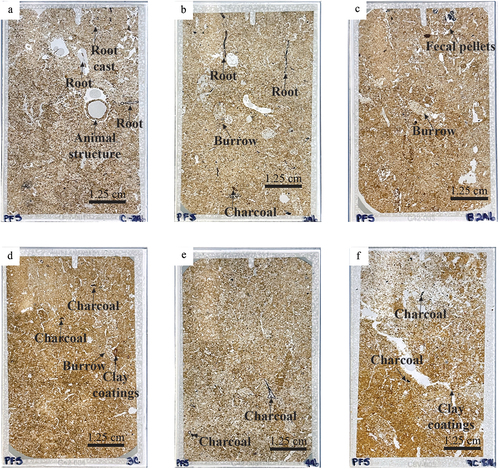
Table 1. Radiocarbon dates on charcoal in the profiles. Note: Shaded ages shown here are interpreted as ages that are overestimated due to erosion and transport of older charcoal.
Table 2. Single-grain OSL ages calculated in quartz grains for the soil profiles.
Figure 7. Age-depth diagrams for the two soil profiles based on AMS radiocarbon and OSL ages from . Error bars represent the ± 2σ errors. Black hollow circles correspond to radiocarbon ages, red color stars correspond to OSL ages. A) Profile A. B) Profile B.
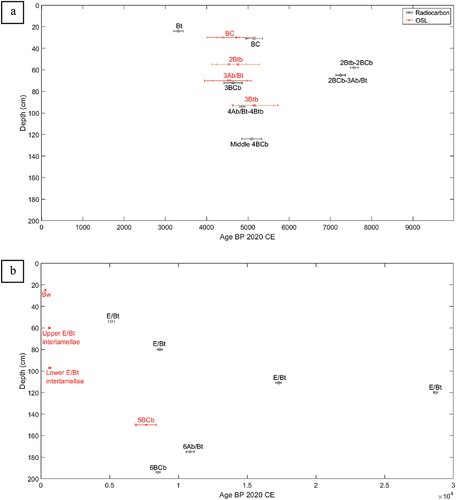
Figure 8. Schematic diagram of clay coating formation in both soil profiles. A) Pedogenesis starts forming soil and soil column develops three horizons, surface soil (Ap), argillic horizon (Bt), and parent material with argillic horizon features (BC). K-feldspar (Kfs), plagioclase (Pl), and muscovite (Ms) start to weather into clay minerals. Clay particles are also available as sediment load from the river. Clay particles travel downward when water infiltrates the soil. During drying periods, clay particles adhere parallel to mineral grain and biopore surfaces, forming clay coatings. B) a depositional event buries the initial soil column, and pedogenesis starts to act in the new fluvial deposits and continues to act in the initial fluvial deposits. Kfs, Pl, and Ms continue to chemically weather into clay minerals, that together with clay carried as suspended sediment from the river continue traveling downwards with water infiltration. New clay coatings form in mineral grain and biopore surfaces in the newer deposits. Older clay coatings receive more clay particles that keep adding and forming thick, and well-developed clay coatings. High permeability, porosity, and well-drained soils allow the newer and the older fluvial deposits to be connected after depositional events.
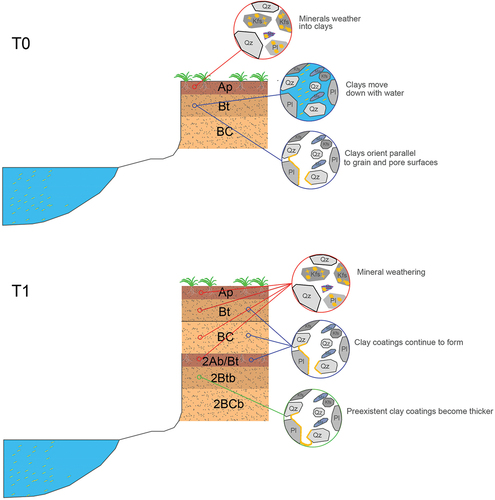
PROFILE A, SAMPLE BC (USU-3028), n = 58 (900).

PROFILE A, SAMPLE BC replicate (USU-3371), n = 37 (1400).
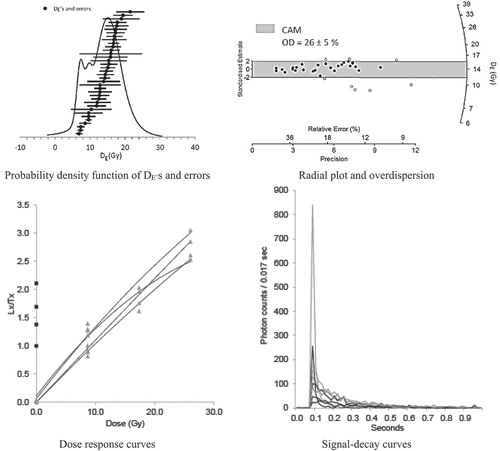
PROFILE A, SAMPLE 2Btb replicate (USU-3372), n = 26 (1500).

PROFILE A, SAMPLE 3Ab/Bt (USU-3030), n = 42 (900).
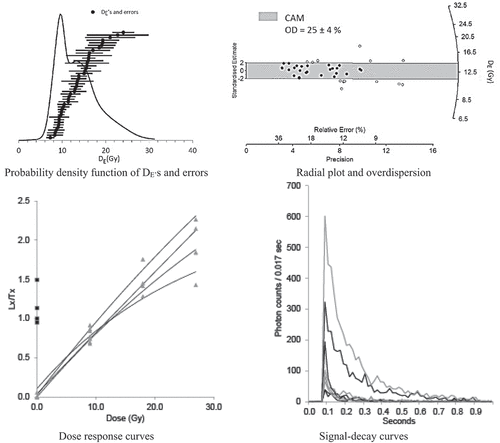
PROFILE A, SAMPLE 3Ab/Bt replicate (USU-3373), n = 27 (1400).
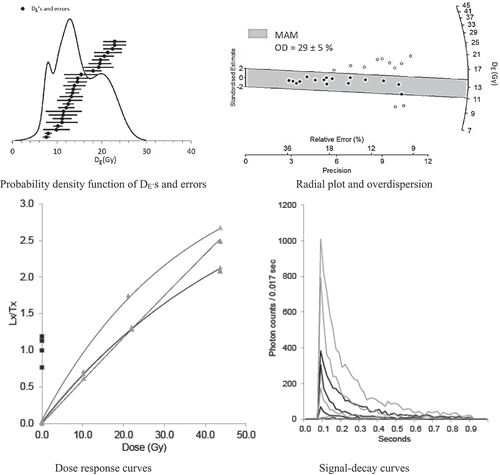
PROFILE A, SAMPLE 4Btb (USU-3031), n = 53 (900).
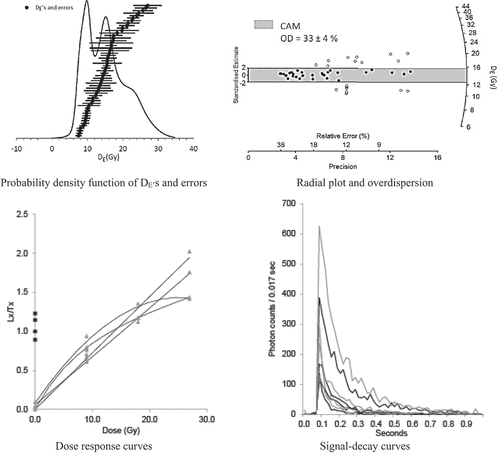
PROFILE A, SAMPLE 4Btb replicate (USU-3374), n = 36 (1400).
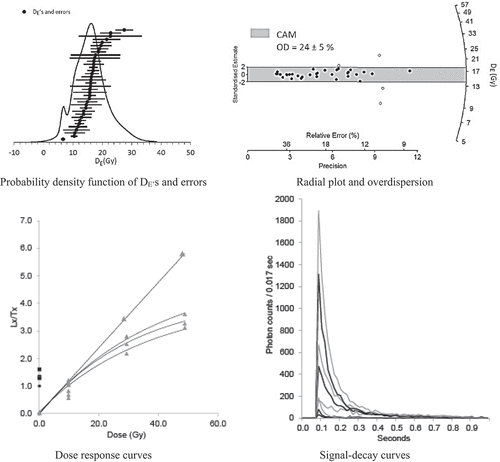
PROFILE B, SAMPLE Bw (USU-3375), n = 37 (1300).
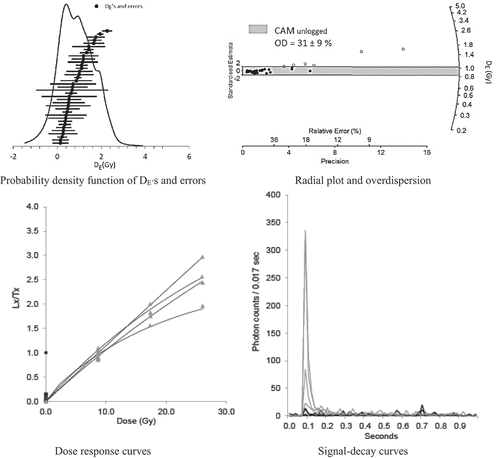
PROFILE B, SAMPLE Bw replicate (USU-3379), n = 41 (1100).
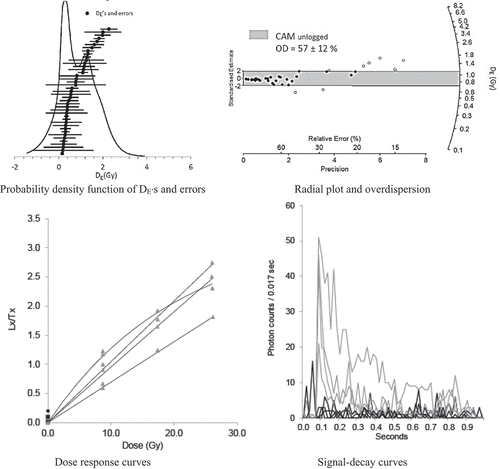
PROFILE B, SAMPLE Upper E/Bt interlamellae (USU-3376), n = 36 (1200).

PROFILE B, SAMPLE Upper E/Bt interlamellae replicate (USU-3380), n = 24 (1100).

PROFILE B, SAMPLE Lower E/Bt interlamellae (USU-3377), n = 35 (1200).
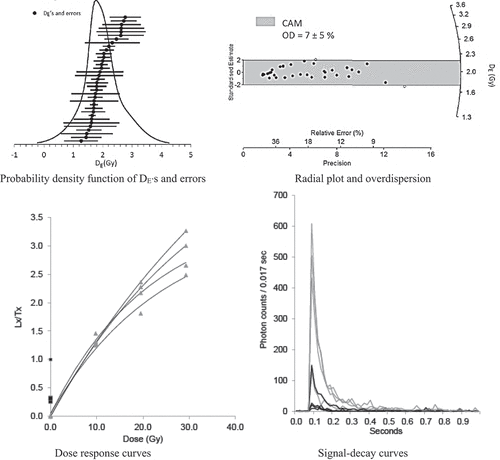
PROFILE B, SAMPLE Lower E/Bt interlamellae replicate (USU-3381), n = 34 (1100).
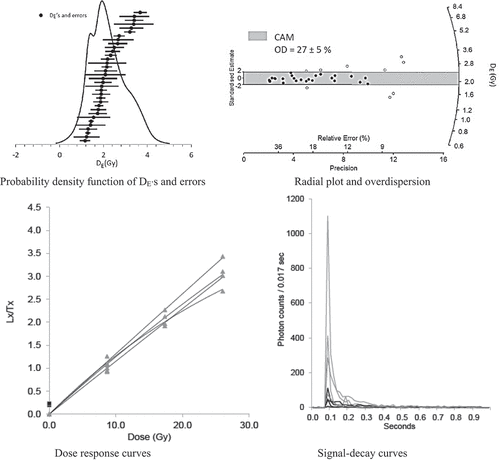
PROFILE B, SAMPLE 5Bcb (USU-3378), n = 31 (2000).
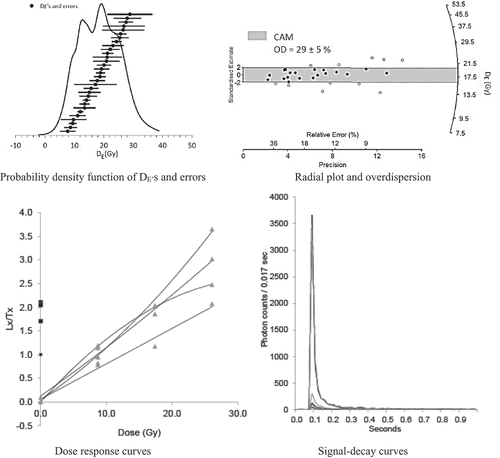
PROFILE B, SAMPLE 5Bcb replicate (USU-3382), n = 44 (2000).
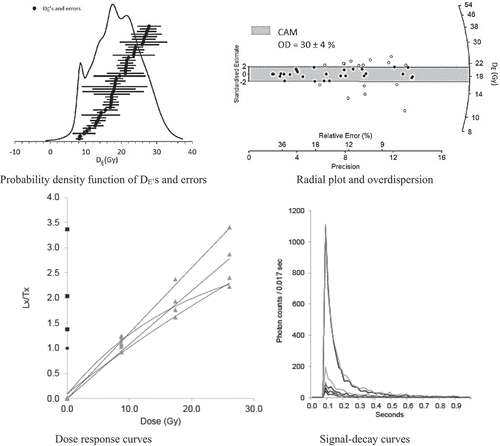
Data availability statement
The authors confirm that the data supporting the findings of this study are available within the article and its supplementary materials.

